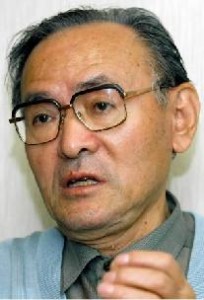1. The ‘Ashes of Death’
Feb. 6, 2013
Chapter 3: The Central, South Pacific and Australia
Part 2: Caught in the Fallout—Daigo Fukuryu Maru
Part 2: Caught in the Fallout—Daigo Fukuryu Maru
The hydrogen bomb exploded by the United States at Bikini Atoll on March 1, 1954, unleashed a new wave of fear throughout the world. The twenty-three crew members of the Japanese tuna trawler Daigo Fukuryu Maru, which was drifting downwind of the explosion, experienced this fear first hand. Thirty-six years have passed since that day, during which time eight of the crew have died, while many of the survivors live with health problems that they claim were caused by exposure to radiation in 1954.
1. The ‘Ashes of Death’
We spoke to Oishi Matashichi, one of the former crew members, at his home in Tokyo. Oishi had worked in the freezing section of the Fukuryu Maru. He was able to relate the events of that day in 1954 to us as clearly as if it were yesterday. "A column of fire shot up into the air, and for a second the sky and sea were bathed in a yellowish glow. It was terrifying." It was 6:45 A.M. local time, one hundred miles east of Bikini, and the crew were engaged in the final trawling operation of their trip. "Seven or eight minutes after the flash of light there was a terrific roar that seemed to shake the sea bed, and the ship was tossed about like a toy," Oishi continued. "Misaki, who was in charge of the fishing side of operations, told us to take up the nets, so we worked frantically to bring in the longline."
The mushroom cloud stretched away above their heads to the east. The sea became rough, and about two hours later white ashes rained down on the vessel. The men could not open their eyes, and it was impossible to breathe outside. It was a six-hour struggle to bring in the net, and during that period all the crew members were exposed to the radioactive fallout. Soon after, they were overwhelmed with nausea, then diarrhea. Suffering from burns and hair loss, they continued their fifty-two-day voyage, limping into their home port on March 14.
The faces of the crew were burned almost black. A local doctor, after hearing their story, diagnosed their condition as acute radiation sickness. Two of the men, who had particularly severe burns, were sent straight to hospitals in Tokyo. The others, including Oishi, followed two weeks later on March 28.
The white blood cell count of the patients decreased day by day. Oishi remembers having diarrhea and a temperature until July. The doctors treated him every day with blood transfusions, vitamin injections, and antibiotics, and slowly his white blood cell count began to recover. No sooner had he begun to improve, however, when his liver failed and he started to show symptoms of jaundice.
In September of the same year, the Bikini test claimed its first victim among the crew, wireless operator Kuboyama Aikichi. He was forty years old. "All the crew were really worried when he died," said Oishi. "We all started to wonder whether we'd be the next to go." Fortunately, all the men were deemed fit enough to be discharged from hospital in May the following year.
Oishi is the eldest of six and had worked on trawlers since the age of thirteen when his father died in the final year of the Second World War. After the incident at Bikini, however, he never felt strong enough to return to fishing. "I stayed at home for a year, then came out to Tokyo and helped my brother with his dry-cleaning business. Of course, I couldn't impose on him forever, so I started off on my own." He now manages a dry-cleaning business with his wife, Nobuko.
"Believe me, I've had more than my fair share of bad luck since getting that dose of radiation. I seem to spend most of my time physically and mentally exhausted. And no matter how hard I try, I just can't forget that day." Sometimes when he has time he goes to see the Fukuryu Maru, which is on display at Yumenoshima in Tokyo, and talks to the mothers and children gathered there. His latest project is an autobiography. "I just wish my body could keep up with all the things I want to do," he told us with a laugh. But on one matter he is extremely serious: "As far as I'm concerned," he told us, "there is no justification whatsoever for nuclear weapons or nuclear testing."
"That experience has meant that I have had to take twice as much care of my health as anyone else. Naturally I'd rather not think about it, but I know I'll never be rid of the radiation." The deaths one by one of his fellow crew members over the last few years have convinced him of this. Not only that, but most of his former workmates died of liver complaints, many similar to the chronic hepatitis which plagued him for years. It is little wonder that Oishi still harbors fears about his own ability to escape the final effect of the huge dose of radiation.








